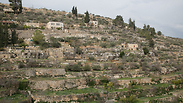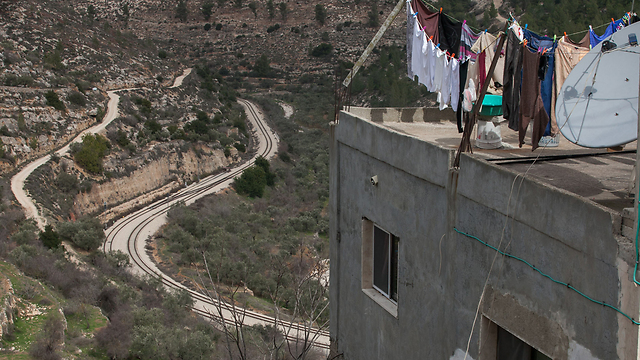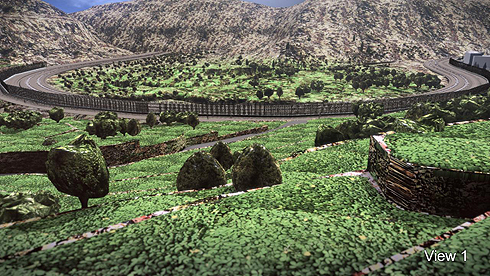
Supreme Court dismisses petition against construction of separation barrier
'This triumph in Battir is a victory for Palestine as whole,' local Palestinian leader says after highly contentious legal battle over barrier fence reaches temporary end, as Israel says construction is low priority, court saying state must inform residents in change of plans.
The Supreme Court has dismissed a petition by Palestinians demanding a halt in construction of the separation barrier in the area of Battir in Gush Etzion in the West Bank. The move came after the Defense Ministry told the court the construction in the area is low priority and is not expected to take place in the meantime.
Though the court threw out the case, citing lack of relevance in light of the state's position, it instructed the state to inform residents should construction be slated to begin and reserved their right to petition the court again.
Palestinians praised the decision, with Akram Badir, head of Battir's local council, telling Palestinian news agency Ma'an that the court's decision was "a victory for Palestine as whole."
According to him, the court "signed a final decision rejecting a request by the Israeli army to build a section of the annexation wall in the village. To make any changes to the decision, the Israeli occupation will have to start new procedures from scratch that will take several years."
The case is unusual as far as anti-fence petitions are concerned, as both settlers and the Palestinians are objecting to the fence's planned route – each for their own reasons.
Legal battle, state's call
In September, Attorney General Yehuda Weinstein gave a legal opinion that empowered the Israeli government to give the final approval for the fence's construction, a decision first made in 2006.
A government decision to approve the construction of the fence in its proposed route would have broad legal, diplomatic and environmental consequences. The move was expected to lead to harsh international criticism against Israel.
The agricultural terraces in Battir (formerly known as Beitar) are nearly 4,000 years old, and are considered a one of a kind heritage site that preserves ancient agricultural methods.
In June, UNESCO inscribed the terraces in Battir on the List of World Heritage in Danger, stating that "the landscape had become vulnerable under the impact of socio-cultural and geo-political transformations that could bring irreversible damage to its authenticity and integrity."
In 2012, the Friends of the Earth Middle East organization petitioned to the Supreme Court of Israel, calling on it to act for the preservation of the terraces because of their importance as a one of a kind environmental and heritage site. The petition also urged a ruling to find an alternative route for the separation fence.
After the Supreme Court held a series of discussions on the issue, led by Supreme Court President Asher Grunis, the court recommended that the government reconsider the planned route for the fence, due in part to the announcement of the site as a World Heritage site, which obligates the government to further deliberate the considerations for its preservation.
Should the government approve the original separation fence route once more, the issue was expected to return to the Supreme Court. Despite the Supreme Court's recommendation to reconsider the fence's route, the assessments were that in light of the attorney general's updated legal opinion, which takes into account the new diplomatic and environmental consequences, the judges would avoid accepting the petition which unequivocally rejects the fence's route.
Another objector of the proposed fence route is Gush Etzion Regional Council head Davidi Perl, who said at the time that "this is a wretched decision that brings us back to the 1967 borders and places the residents of Gush Etzion under Palestinian sovereignty. This goes against the spirit of the settlements, and in actuality throws the Gush's residents outside the fence and outside the territories of the State of Israel."
Perl went on to say that the demarcation of the Green Line with a fence will also prevent settlement expansion to the 4,000 dunam area that Israel decided to annex last month.
On the opposite side, the Defense Ministry said that "the security fence's route near the Battir village in southern Jerusalem is the last breach left in the protection of the residents of Jerusalem. The route was planned according to clear security needs that have been recognized by the Supreme Court - preventing terrorists from freely entering Jerusalem and the Israeli home front, and defending the train tracks to the capital, that pass near that route."
Though now it seems the Defense Ministry has changed its mind, saying the area was low priority.
In an interview with Defense Minister Moshe Ya'alon in the Makor Rishon newspaper three months ago, the minister said: "It's not a priority at all. I could use the excuse that we don't have the money, but the point is that I don't see a need at the moment for a fence around Gush Etzion."
Elior Levy, Itay Blumental, Yoav Zitun and Attila Somfalvi contributed to this report













